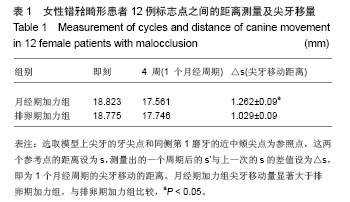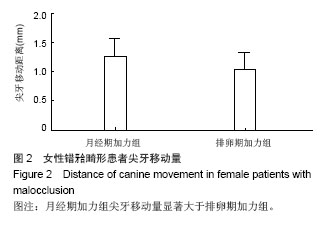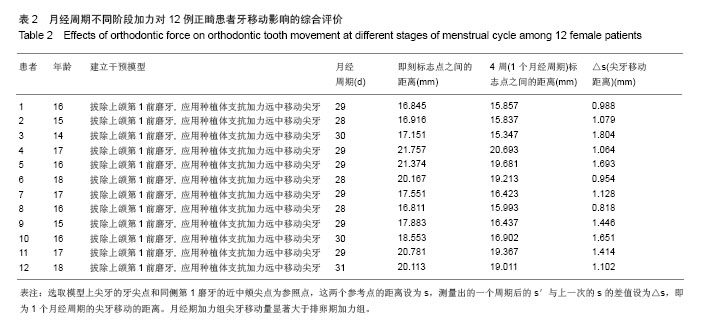| [1]张琳琳,戴红卫,吴杨,等.大鼠正畸牙根吸收修复早期BMP-2与BSP表达的研究[J].重庆医学,2010,39(10):1214-1218.
[2]李新桂,刘月华,张寅,等.正畸力对大鼠牙根吸收后早期修复的影响[J].临床口腔医学杂志,2010,26(2):86-88.
[3]姜欢,胡敏. 正畸牙移动相关牙根吸收研究进展[J].口腔医学研究, 2011,27(2):168-170.
[4]李新桂,董志强,刘月华,等.正畸牙移动早期牙根吸收的临床研究[J].中华口腔正畸学杂志,2011,18(2):84-88.
[5]陈莉花,陈文静,顾敏,等.大鼠牙移动过程中牙周膜中Runx2的表达[J].口腔医学,2010,30(5):286-288.
[6]郭杰,赵青,陈扬熙,等.动情周期不同阶段正畸牙移动影响牙周组织胰岛素样生长因子表达的研究[J].华西口腔医学杂志,2008, 26(4):439-442.
[7]彭鹏,蔡萍,等. 生长因子在正畸牙移动牙周组织改建中的作用[J].国际口腔医学杂志,2012,39(2):252-256.
[8]毛志贵,房兵,毛丽霞,等.牙周病患者正畸前后牙槽骨密度变化的CBCT研究[J].中华口腔正畸学杂志,2010,17(4):197-200.
[9]韩光丽,程祥荣,贺红,等. 正畸过程中牙周韧带细胞增殖能力的实验研究[J].口腔正畸学,2001,8(2):82-84.
[10]Abuabara A. Biomechanical aspects of external root resorption in orthodontic therapy. Med Oral Patol Oral Cir Bucal. 2007;12(8):E610-613.
[11]Hu W, Featherstone JD. Prevention of enamel demineralization: An in-vitro study using light-cured field sealant. Am J Orthod Dentofacial Orthop. 2005;128(5): 592-600.
[12]McComb JL. Orthodontic treatment and isolated gingival recession:a review. Br J Orthod. 1994;21(2):151-159.
[13]冯立晓,马文盛. 加速正畸牙齿移动速度研究进展[J].2009,30(4):424-426.
[14]Jacob S, Spencer NA, Bullivant SB, et al. Effects of breastfeeding chemosignals on the human menstrual cycle. Hum Reprod. 2004;19(2):422-429.
[15]Morishita M, Shimazu A, Iwmaoto Y.Analysis of oestrogen receptor mRNA by reverse transcriptase-polymerase chain reaction in human periodontal .Arch Oral Biol. 1999; 44(9): 781-783.
[16]肖妱穆,潘晓岗. 有关正畸牙移动力学作用的研究进展[J].口腔材料器械,2012,21(3):153-157.
[17]包幸福,胡敏. 正畸牙移动中骨吸收机制及其调控的研究进展[J].国际口腔医学杂志,2012,39(2):187-189.
[18]尹林玲,房兵. 牵引成骨技术在正畸牙移动中应用的研究进展[J].国际口腔医学杂志,2010,37(2):229-232.
[19]Cuzzocrea S, Mazzon E, Dugo L, et al. Inducible nitric oxide synthase mediates bone loss in ovariectomized mice. Endocrinology. 2003;144(3):1098-1107.
[20]卢云,贵林,杨茜,等. 10种国内期刊正畸牙移动动物模型应用研究的统计分析[J].口腔医学研究,2012,28(5):460-463.
[21]王威,王邦康,刘郁,等. 大鼠正畸牙移动压力侧牙槽骨中cath K mRNA表达的研究[J].北京口腔医学,2010,18(2):65-68.
[22]陈彬,李琥,陈文静,等. 大鼠正畸牙移动中HIF-1α的表达[J].口腔生物医学,2011,2(2):78-81.
[23]谭礼俊,王军,赵志河,等.骨质疏松老年大鼠正畸牙移动实验[J].四川大学学报(医学版),2006,37(3):449-451.
[24]Roberts WE, Chase DC. Kinetics of cell proliferation and migration associated with orthodontically-induced osteogenesis. J Dent Res. 1981;60(2):174-181.
[25]苏丹,孙娟. 女性月经周期对正畸牙移动影响的研究[J].亚太传统医药,2011,7(10):131-133.
[26]苏丹,王生瑜. 正畸牙移动与月经周期的相关性[J].中国中医药资讯,2010,2(31):355-356.
[27]郭杰,车晓霞,曾祥龙,等. 正畸牙移动与月经周期关系的实验研究[J].上海口腔医学,2007,16(2):187-191.
[28]朱洵,高嵩,胡佩诚. 月经周期对女性与性兴奋相关神经活动的调控[J]. 中国性科学,2010;19(9):32-37.
[29]阿依木.迪亚尔,陈占功,等. 正常青年女性月经周期ABR变化观察[J]. 听力学及语言疾病杂志,2006,14(6):463-465.
[30]雷琼,陈燕. 镍钛拉簧及橡皮链远中移动尖牙的疗效观察[J].四川医学,2011,32(12):1912-1914.
[31]Yoshida T, Yamaguchi M, Utsunomiya T, et al.Low-energy laser irradiation accelerates the velocity of tooth movement via stimulation of the alveolar bone remodeling. Orthod Craniofac Res. 2009;12(4):289-298.
[32]Iseri H, Kisnisci R, Bzizi N, et al.Rapid canine retraction and orthodontic treatment with dentoalveolar distraction osteogenesis. Am J Orthod Dentofacial Orthop. 2005;127(5): 533-541.
[33]Henao SP, Kusy RP. Evaluation of the frictional resistance of conventional and self- ligating bracket designs using standardized archwires and dental typodonts. Angle Orthod. 2004;74(2):202-211.
[34]Kawakami M, Takano-Yamamoto T. Local injection of 1, 25-dihydroxyvitamin D3 enhanced bone formation for tooth stabilization after experimental tooth movement in rats. J Bone Miner Metab. 2004;22(6):541-546.
[35]Kalia S, Melsen B, Verna C. Tissue reaction to orthodontic tooth movement in acute and chronic corticosteroid treatment. Orthod Craniofac Res. 2004; 7(1):26-43.
[36]Ren A, Lv T, Kang Na, et al. Rapid orthodontic tooth movement aided by alveolar surgery in beagles. Am J Orthod Dentofacial Orthop. 2007;131(2):160.e1-10.
[37]Lewko WM, Andersona A. Estrogen receptors and growth response in cultured human periodontal ligament cells. Life Sci.198;39(13):1201-1206.
[38]Holland EF,Studd JW,Mansell JP, et al. Changes in collagen composition and cross-links on bone and skin of osteoporotic Postmenopausal women treated with percutaneous estradiol implants. Obstet Gynecol. 1994;83(2):180-183.
[39]Yamashiro T, Takano-Yamamoto T. Influences of ovariectomy on experimental tooth movement in the rat. J Dent Res. 2001; 80(9):1858-1861.
[40]Morishita M, Yamamura T, Bachchu MA,et al.The effects of oestrogen on osteocalcin production by human periodontal ligament cells. Arch oral Biol. 1998;43(4):329-333.
[41]Cao M, Shu L, Li J, et al. The expression of estrogen receptors and the effects of estrogen on human periodontal ligament cells. Methods Find Exp Clin Pharmacol. 2007; 29(5):329-335.
[42]Liang L, Yu JF, Wang G, et al. Effect of estrogen receptor beta on the osteoblastic differentiation function of human periodontal ligament cells. Arch Oral Biol. 2008; 53(6): 553-557.
[43]Zhou Y, Fu Y, Li JP, et al. The role of estrogen in osteogenetic cytokine expression in human periodontal ligament cells. Int J Periodontics Restorative Dent. 2009;29(5):507-513.
[44]陈雁南,李晓智,陈新,等. 局部注射不同浓度骨保护素对大鼠正畸牙移动影响的研究[J].激光杂志,2011,32(5):89-92.
[45]Spelsberg TC, Subramaniam M, Riggs BL. The actions and interactions sex steroids and growth factors/cytokines on the skeleton. Mol Endocrinol. 1999;13(6):819-828.
[46]Arslan SG, Arslan H, Ketani A, et al. Effects of estrogen deficiency on tooth movement after force application:an experimental study in ovariectomized rats. Acta Odontol Scand. 2007;65(6):319-323. |



.jpg)
.jpg)